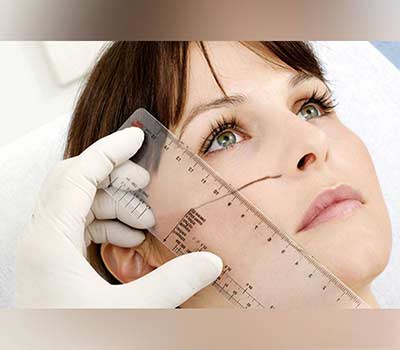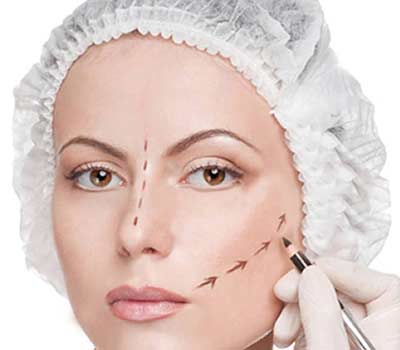 The facelift is without a doubt one of the most representative and best-known interventions in cosmetic surgery. It is also one of the most gratifying ones that allows to correct the aging effects of the face (and the spirit) of the individual.
The facelift is without a doubt one of the most representative and best-known interventions in cosmetic surgery. It is also one of the most gratifying ones that allows to correct the aging effects of the face (and the spirit) of the individual.
A facelift or rhytidectomy is a surgery to rejuvenate the facial contours, including all regions of the face and the anterior and lateral cervical areas.
A facelift doesn’t stop the clock, but it can slow it down, improving the most visible signs of facial aging.
Indications
The ideal candidate for a facelift is a psychologically stable man or woman without significant illness whose skin on the face and neck has begun to “sag” but still has some elasticity and whose bone structure is well defined. Most patients are between 40 and 60 years old, but facelifts can be successfully performed on people in their 70s and 80s as well.
The consultation
During the initial consultation you will likely be asked to look in a mirror and point out the areas you want to see improved. This allows you to understand your expectations, what you want to correct.
In the preoperative evaluation, several elements are taken into account, ranging from age, weight, and certain risk factors such as tobacco, alcohol and sun. The thickness, texture and elasticity of the skin and the severity of wrinkles and folds are evaluated. Your hairline will be examined to determine where incisions can be discreetly placed. All these factors as well as your bone structure and underlying tissues (muscle and fat) will be considered. Certain scars can make the indication of a facelift dangerous when they are extensive.
The plastic surgeon should assess whether there are any medical conditions that could cause problems during or after surgery, such as uncontrolled high blood pressure, problems with blood clotting, or a tendency for excessive scarring. If you smoke or take medication, especially aspirin or other anti-inflammatory drugs that affect clotting.
Your plastic surgeon can discuss additional procedures with you that can be performed in conjunction with your facelift to address any concerns you have identified. For example. a facelift is often combined with a facelift, eyelid surgery, rhinoplasty, or skin treatments such as chemical peels, dermabrasion, or lasers. Do not hesitate to ask any questions you have, especially those related to your expectations and concerns about the results.
The Surgery
Preparation for surgery
If you smoke, it is especially important to stop for at least one to two weeks before and after surgery, as tobacco can interfere with the healing of your incisions. Aspirin and certain anti-inflammatories can cause increased bleeding, so they should be stopped two weeks before surgery.
If your hair is short, you can wait for it to grow long enough before surgery to easily hide the scars while they heal.
What anesthesia is used?
As for the mode of anesthesia, some cases are performed under local anesthesia combined with sedation to make you sleepy but awake, awake but relaxed, and your face is insensitive to pain. Other surgeons prefer general anesthesia, in this case you sleep during the surgery, this situation is the most comfortable for the patient as well as for the surgeon.

Where are the incisions placed?
The exact placement of the incisions depends on your facial structure and your surgeon’s technique. The incisions usually start in the hair, in the area of the temples and extend into a skin fold that usually exists in front of the ear (immediately inside the cartilage that is in front of the ear) and continues behind the ear lobe to the retroauricular sulcus. then moving on to the hair on the back of the neck. If the neck needs work, a small incision can also be made under the chin. Usually, the surgeon separates the skin from the fat and muscle below. Fat can be cut or vacuumed from the neck or chin to improve the contour. The surgeon then stretches the underlying muscle, pulls the skin back and up, and removes the excess. The stitches secure the various layers of tissue and close the incisions,
Where is the surgery performed?
Your facelift can be performed in a hospital or an outpatient surgery center. The surgery takes an average of 3 hours, it will take longer if you perform more than one procedure.
After Surgery
What care?
After the surgery, a small drain may be temporarily placed under the skin coming out behind the ear to drain any blood that may accumulate. The surgeon will also place a “helmet” dressing, with bandages around your head to minimize bruising and swelling. The dressing should be moderately compressive and comfortable. This dressing is kept for 2 days, then it will be replaced by a lighter compressive dressing, kept until the pre-auricular stitches are removed between the 4th and 7th postoperative day. You should keep your head up for a couple of days. Drainage will be removed 1 or 2 days after surgery.
After the bandages are removed, don’t be surprised by the pallor, bruising, and swelling of your face. Don’t be alarmed by small irregularities or temporary asymmetries caused by swelling and bruising that are perfectly normal. Usually, the biggest swelling occurs 24 to 48 hours after surgery, but it takes a few weeks to go away completely.
When can I return to normal activities?
You can get up within a day, but you should have very light activity in the 1st week after the surgery. You should be especially careful with your face and hair, as the skin is tight and numb and doesn’t “respond” normally.
In the vast majority of cases, you will be able to resume most of your normal activity within 2 weeks, improving greatly until 3 or 4 weeks after surgery.
You should, however, avoid intense physical activity, including sex and heavier work, for at least 2 weeks (walking is good); and avoid alcohol, tobacco, Turkish bath and sauna for several months. You will be told to temporarily avoid direct sun exposure and long-term use sunscreen to protect your skin.

The results
The results of your facelift can be dramatic or subtle, depending on how you look before surgery as well as the specific goals you and your plastic surgeon have set. Since the healing process is gradual, you should wait at least several weeks to get a more realistic idea of your new “look”. At first, your face may look strange. Details may be distorted by swelling; facial movements may be slightly “stiff” and you will likely be aware of scars. Some bruising may persist for 2 or 3 weeks. It is therefore not surprising that some patients are disappointed and depressed at first.
By the 3rd week, you look and feel much better. Most patients return to work about 10 to 15 days after surgery. Camouflage makeup can cover up much of the bruising that remains. The probability of being satisfied with your facelift is high, especially if you are aware that the apparent results may not be immediate.
Duration of results
The duration of your facelift results depends on many variables including your heredity and lifestyle.
Having a facelift doesn’t stop the clock, but even though the aging process continues, patients are generally happy with how they look for many years after a facelift. Years later they still look better than if they never had a facelift. The procedure can be repeated, one or more times, about 5 or 10 years later.







